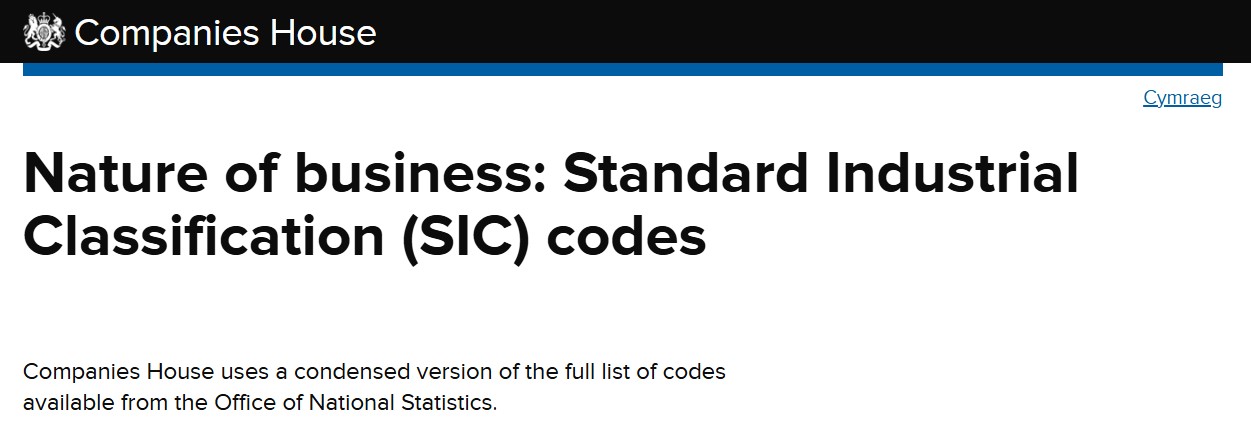Last Updated on August 6, 2025 by Joy Kyalo

UK company formation for just £0.99 and get your UK virtual office address for only £0.88 – available for both UK and non-UK residents!
If you are starting your company in the UK, you have probably come across the Standard Industrial Classification (SIC) code and might be wondering what that is. When incorporating a UK limited company, people tend to fill in SIC code without understanding its meaning. SIC code classifies your business activity. Each business activity has its own SIC code and companies have an obligation to notify Companies House annually of the business they conduct. If your business activity changes, it’s important to know how to change SIC code on Companies House to ensure your records are up to date.
How do I know my SIC code? This article will highlight how you can choose a SIC code that aligns with your business, how to change SIC code on Companies House in case you change to a different kind of business, and the main section of SIC code.
What is SIC code?
The Standard Industrial Classification (SIC) code is a five-digit numerical code used to categorise business activities in the UK. When forming a UK limited company, you have to submit SIC code to Companies House to inform them of your business activities.
When incorporating a company, a company must choose between 1 to 4 SIC codes that reflect the type of business your company is conducting.
The UK utilises a distinct system for Standard Industrial Classification referred to as the UK Standard Industrial Classification (UK SIC). This system was last updated in 2007 and features more than 700 five-digit SIC codes.
Understanding Standard Industrial Classification (SIC) Codes

The SIC codes are classified into sections and categorised by letters each representing a broad sector of economic activity. The sections assist in classifying companies in their respective divisions based on the core activities of such firms which eases statistical and regulatory purposes.
- A: Agriculture, Forestry, and Fishing
- B: Mining and quarrying
- C: Manufacturing
- D: Electricity, Gas, Steam and air conditioning
- E: Water supply, sewerage, waste management and remediation activities
- F: Construction
- G: Wholesale and retail trade; repair of motor vehicles and motorcycles
- H: Transport and storage
- I: Accommodation and food service activities
- J: Information and communication
- K: Financial and insurance activities
- L: Real estate activities
- M: Professional, scientific, and technical activities
- N: Administrative and support service activities
- O: Public administration and defence; compulsory social security
- P: Education
- Q: Human health and social work activities
- R: Arts, entertainment, and recreation
- S: Other service activities
- T: Activities of households as employers, undifferentiated goods, and service-producing activities of households for own use
- U: Activities of extraterritorial organisations and bodies
Once you understand SIC code sections, now you have to understand how to read it. If you are in the manufacturing industry, your SIC code will be broken down into the letter section, division which will have two digits, group which will have 3 digits, class with four digits, and subclasses with five digits. For example:
| Section | C | Manufacturing |
| Division | 10 | Manufacture of Food Products |
| Group | 10.1 | Manufacture of Dairy Products |
| Class | 10.51 | Operation of Dairy and Cheese Making |
| Subclass | 10.51/2 | Butter and Cheese Production |
For the list of business activities with their respective SIC code provided by Companies House please Click Here.
How many SIC codes does a company have to register?
Typically, a company is expected to have one SIC code that most suitably represents its business activities. However, it is permissible for companies to choose up to four SIC codes for the classification of their business operations.
Having a lot of codes may be confusing mostly when it comes to taxes and finance. Adding SIC code is not necessary unless it is needed. The process of choosing the most suitable SIC code or codes for the company is not an easy task in certain instances. There can, however, be times when choosing the codes proves to be tricky and, in such cases, seeking the help of a company formation agent such as BusinAssist who will advise on the appropriate codes for registration with Companies House is recommended.
How are SIC codes used?
Industry classification: They define activities that characterise a business in a singular way or in terms of its economic activity. This also allows econometric data processing because industries can be grouped within a specific framework.
Data collection for analysis: Orders of Regulation should incorporate SIC codes as identifying features of the data elements collected for regulation and analysis of the economy. This includes the assessment of economic, occupational, and industrial development.
Tax authorities: It is possible that SIC Classification can be implemented for tax rate determination and tax compliance for various categories of businesses.
For businesses and academia: Many firms and analysts use SIC classification to forecast growth, perform industry and competitor assessments, and evaluate industries.
Financial and non-financial service providers: Banks and Insurers employ SIC classifications while evaluating the risk and qualification of borrowers and insured persons in such contracts as loans and insurance policies. Some industries may be more prone to risk which may influence terms and conditions of the loan.
Supply chains and services: SIC codes are sought after by businesses and governments to delimit suppliers and subcontractors within certain business sectors.
Why might I need to change a company SIC code?
Business diversification: If your company expands into new industries or markets, you may need to update your SIC code to reflect these new activities.
Business focus shift: If your company’s primary business activity changes, updating the SIC code ensures it accurately represents your main line of business.
Regulatory compliance: Certain industries have specific regulatory requirements. Ensuring your SIC code is accurate can help with compliance and reporting.
Market analysis and research: Accurate SIC codes can improve the quality of market research and analysis, helping you better understand industry trends and competition.
Financial reporting: Investors and stakeholders often use SIC codes to assess a company’s industry and performance. Accurate codes can provide clearer insights.
How do I update my company’s SIC code on Companies House?
To update your company’s SIC code on Companies House, follow these steps:
Log in to Companies House: Access the Companies House online service using your email address, password, and authentication code.
File a Confirmation Statement (CS01): You need to file a Confirmation Statement to update your SIC code. This can be done at any time during the year, not just at the annual due date.
Update SIC Code: Within the Confirmation Statement, you can add or change the SIC code(s) that best describe your company’s activities.
Submit the form: Once you’ve updated the SIC code, submit the Confirmation Statement online. Ensure all details are accurate before submission.
Pay any fees: There may be a small fee associated with filing the Confirmation Statement.
Verify the change: After submission, verify that the new SIC code is correctly reflected in your company’s records on Companies House.
Conclusion:
SIC codes are important since they classify your business activity. The availability of numerous SIC codes allows for the possibility that multiple companies may be categorised under the same code. It’s important to keep in mind that there’s no need to worry about Companies House penalising you if you make a mistake. The enforcement of SIC codes is not strict. However, if your business activity changes, you should know how to change SIC code on Companies House to keep your records accurate.
When you start a UK company with BusinAssist, we will help you choose SIC code that best describes your business. We will help you handle the paperwork and submit them to Companies House for approval.
We also file Confirmation Statements fast and accurately at an affordable price. Our goal is to submit all Confirmation Statements within 3 business days of receipt of your order.
In case you are missing documents or codes from Companies House, we will assist you in obtaining them at no extra charge. If your statement is late and Companies House is considering imposing a fine or taking legal action against you, we will communicate with them on your behalf to try to resolve the matter and seek an extension for you.
For more information, contact us at info@businassist.com.
FAQs
Q: How to add SIC code to the company?
Ans: To add SIC code to the company one will simply need to use the Companies House online services. Once logged in, find and select the company you want to update. You can update your SIC code while filing a Confirmation Statement. As you go through the Confirmation Statement, you will reach a section for SIC codes. Here, you can add, change, or remove SIC codes as needed. If this seems very foreign to you, you can reach BusinAssist who will help you add SIC code to the company.
Q: How to find SIC code?
Ans: Your company’s SIC code will depend on the specific business activities. To find the correct SIC code, you should identify your industry by determining the primary business activities your company engages in. You can use online tools like the Companies House SIC code lookup to search for the code that best matches your business activity. A company formation agent like BusinAssist can help you identify the appropriate SIC code for your company.
Q: What does SIC code stand for?
Ans: SIC code is an acronym for Standard Industrial Classification.
Q: Can a company have different SIC codes?
Ans: Yes, a company can have multiple SIC codes. This is especially common for businesses that operate in various sectors or offer a range of products and services. Each SIC code represents a different line of business activity. For example, a company that manufactures electronics and also provides consulting services might have one SIC code for manufacturing and another for consulting.
Q: What happens if you use the wrong SIC code?
Ans: Using the wrong SIC (Standard Industrial Classification) code when setting up your ltd company can have a few implications, but fortunately, it’s not a critical issue. There are no penalties for using the wrong SIC code, however, your business might be misclassified, which can affect how it’s perceived by lenders, insurers, and other stakeholders. Banks and Ecommerce platforms may also require you to use the correct SIC code with Companies House. If you realise you’ve used the wrong SIC code, you can correct it by filing a confirmation statement with Companies House.
Read Also:
- Lost Your Government Gateway User ID and Password? Here’s How to Find Them
- Share Capital: Key Advantages and Disadvantages Every Business Owner Should Know
- Updates: Changes in Companies House Requirements for a Registered Office Address
- Everything You Need to Know About Companies House Default Address
- Companies House Late Filing Penalties: What You Need to Know in 2025
- How to Fill Out a Stock Transfer Form J30: A Step-by-Step Guide
- The Hidden Costs of Being VAT Registered: Is It Killing Your Business?
- Why would a Company Register a Charge with Companies House?
- Trade Name Vs. Company Name: What Every Small Business Owner Needs to Know

Joy is a content writer at BusinAssist with 6+ years of experience in content marketing and social media strategy. She specialises in company formation and virtual operations, guiding entrepreneurs through global markets with clarity, drawing on her marketing and PR background. Business Assist with BusinAssist – your business success partner.


Way cool! Some very valid points! I appreciate you penning this article
plus the rest of the site is really good.